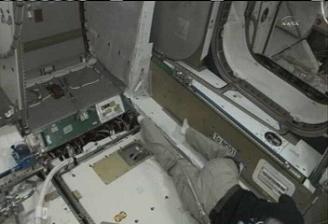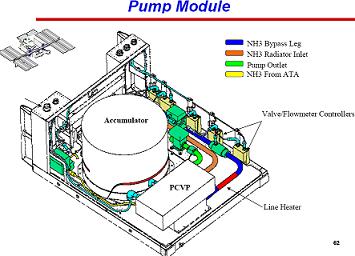Expedition 25 Flight Engineer Fyodor Yurchikhin closed and performed leak checks on the hatch between the International Space Station and the ISS Progress 37 cargo ship Friday, completing preparations for the craft’s undocking.
The Progress is scheduled to undock from the Pirs docking compartment Monday at 10:25 a.m. EDT. It will spend three weeks orbiting a safe distance from the station to enable Russian engineers to conduct technology experiments before being deorbited Nov. 15.
The undocking of Progress 37 sets the stage for the launch of the new ISS Progress 40 cargo ship on Wednesday from the Baikonur Cosmodrome in Kazakhstan. The new Progress is loaded with 1,918 pounds of propellant, 1,100 pounds of oxygen, 498 pounds of water and 2,804 pounds of food, spare parts and supplies for the Expedition 25 crew. It will dock to the station’s Pirs docking compartment Oct. 30.
A new technology demonstration produced the first quart, or liter, of water for the station’s water recycling system overnight. The Sabatier system uses a technology developed by 1912 Nobel Prize winner Paul Sabatier to extract water from the byproducts of the station’s Oxygen Generation System and Carbon Dioxide Removal Assembly. The system can produce up to 530 gallons (2,000 liters) of water each year. The system was integrated into the Water Recovery System on the space station last week and checkout was completed this week. The Sabatier process involves using a nickel catalyst to interact with hydrogen and carbon dioxide at elevated temperatures and pressures to produce water and methane. The water is retained for recycling processes, and the methane is vented overboard. The demonstration is a joint effort of NASA and Hamilton Sundstrand.
Flight Engineer Shannon Walker continued her work with the Japanese experiment HydroTropi. The botanical experiment takes place in the Kibo laboratory and studies how plants, such as a cucumber, grow at a molecular level in microgravity. Data obtained from the results may lead to significant advancements in agricultural production on Earth.
 ISS025-E-007772 (18 Oct. 2010) --- NASA astronaut Shannon Walker, Expedition 25 flight engineer, works with the Japan Aerospace Exploration Agency (JAXA) experiment HydroTropi (Hydrotropism & Auxin-Inducible Gene Expression in Roots Grown under Microgravity Conditions) in the Kibo laboratory of the International Space Station.
ISS025-E-007772 (18 Oct. 2010) --- NASA astronaut Shannon Walker, Expedition 25 flight engineer, works with the Japan Aerospace Exploration Agency (JAXA) experiment HydroTropi (Hydrotropism & Auxin-Inducible Gene Expression in Roots Grown under Microgravity Conditions) in the Kibo laboratory of the International Space Station.
Commander Doug Wheelock performed a periodic fitness evaluation on Flight Engineer Scott Kelly.
Wheelock also deactivated the Atmosphere Revitalization rack in the Tranquility module to work with the low-temperature loop quick disconnects there. He also worked with the Harness Development Test Objective, which is evaluating harnesses for use with the COLBERT treadmill. The harness applies pressure that causes a crew member’s footfalls to mimic Earth gravity as closely as possible, as a countermeasure against bone density loss and muscle degradation in microgravity.
 ISS025-E-008371 (20 Oct. 2010) --- NASA astronaut Doug Wheelock, Expedition 25 commander, uses Neurospat hardware to perform a science session with the European Space Agency PASSAGES experiment in the Columbus laboratory of the International Space Station. PASSAGES is designed to test how astronauts interpret visual information in weightlessness. It aims at studying the effects of microgravity on the use of the 'Eye-Height' strategy for estimating allowed actions in an environment, and whether this could possibly decrease after a long exposure to weightlessness.
ISS025-E-008371 (20 Oct. 2010) --- NASA astronaut Doug Wheelock, Expedition 25 commander, uses Neurospat hardware to perform a science session with the European Space Agency PASSAGES experiment in the Columbus laboratory of the International Space Station. PASSAGES is designed to test how astronauts interpret visual information in weightlessness. It aims at studying the effects of microgravity on the use of the 'Eye-Height' strategy for estimating allowed actions in an environment, and whether this could possibly decrease after a long exposure to weightlessness.
Flight Engineers Alexander Kaleri and Oleg Skripochka configured audio on the orbital complex’s communication systems.
As the newest inhabitants of the orbital complex, Kaleri, Skripochka and Kelly spent time orienting themselves to their surroundings.
 ISS025-E-008196 (19 Oct. 2010) --- NASA astronaut Scott Kelly, Expedition 25 flight engineer, uses a still camera to photograph the topography of a point on Earth from a window in the Cupola of the International Space Station.
ISS025-E-008196 (19 Oct. 2010) --- NASA astronaut Scott Kelly, Expedition 25 flight engineer, uses a still camera to photograph the topography of a point on Earth from a window in the Cupola of the International Space Station.
Space shuttle Discovery will launch Nov. 1 to begin the STS-133 mission the space station. On the orbiter’s final spaceflight, the crew members will install the Permanent Multipurpose Module and deliver important spare parts to the station along with the Express Logistics Carrier-4 and Robonaut 2.























